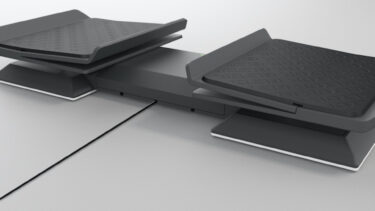This "hoverboard" is designed to facilitate movement in Virtual Reality

Say goodbye to tired hands: GLYDR lets you control VR games comfortably with your feet.
"Wouldn't it be cool if you could use the concept of the hoverboard, where you float through space with two feet and slight movements, as a digital input?" asks Rick Tett in an interview with his former university.
At this point, the inventor and two colleagues have long since turned their idea into reality and are in the process of bringing the "Glydr" to market.
If the word "hoverboard" makes you think of the futuristic floating skateboards from the science fiction classic "Back to the Future", you might be a little disappointed. Although the "Glydr" looks like one of these boards, the peripheral board cannot hover. Instead, it is a dual analog foot controller for video and VR games.
Relief for gamers' hands
The developers want to offer gamers a way to take the strain off their hands during long gaming sessions and transfer certain inputs from game and VR controllers to their feet. Functions such as muting other players in multiplayer games, push-to-talk or taking screenshots can be triggered with the toes.
Jumping, ducking and shooting are also possible. Every action of the controller buttons can be transferred to the foot controller. Glydr is fully compatible with every PC game and is configured using the app supplied.
Free movement in three-dimensional space
If you want to use the Hoverboard in Virtual Reality, connect it to your VR headset via Bluetooth. Of course, you can only play while sitting down, but controlling VR games with your feet is even more space-saving.
For VR games, the function of moving around the VR environment should be of particular interest. By simply rocking your feet in the appropriate direction, you can move forward, backward, or sideways. According to the developers, full movement in three-dimensional space should be possible.
Not the first foot controller for VR
Glydr is being funded via a Kickstarter campaign, which currently stands at just over $64,000 and 380 backers. Cybershoes, which was also funded via Kickstarter in 2018, takes a similar approach to movement in VR.
These shoes are also worn while sitting. Rollers embedded in the soles allow the feet to glide gently back and forth, and sensors transmit the movements into Virtual Reality. The idea is to create a more realistic walking experience and reduce the risk of motion sickness.
Note: Links to online stores in articles can be so-called affiliate links. If you buy through this link, MIXED receives a commission from the provider. For you the price does not change.